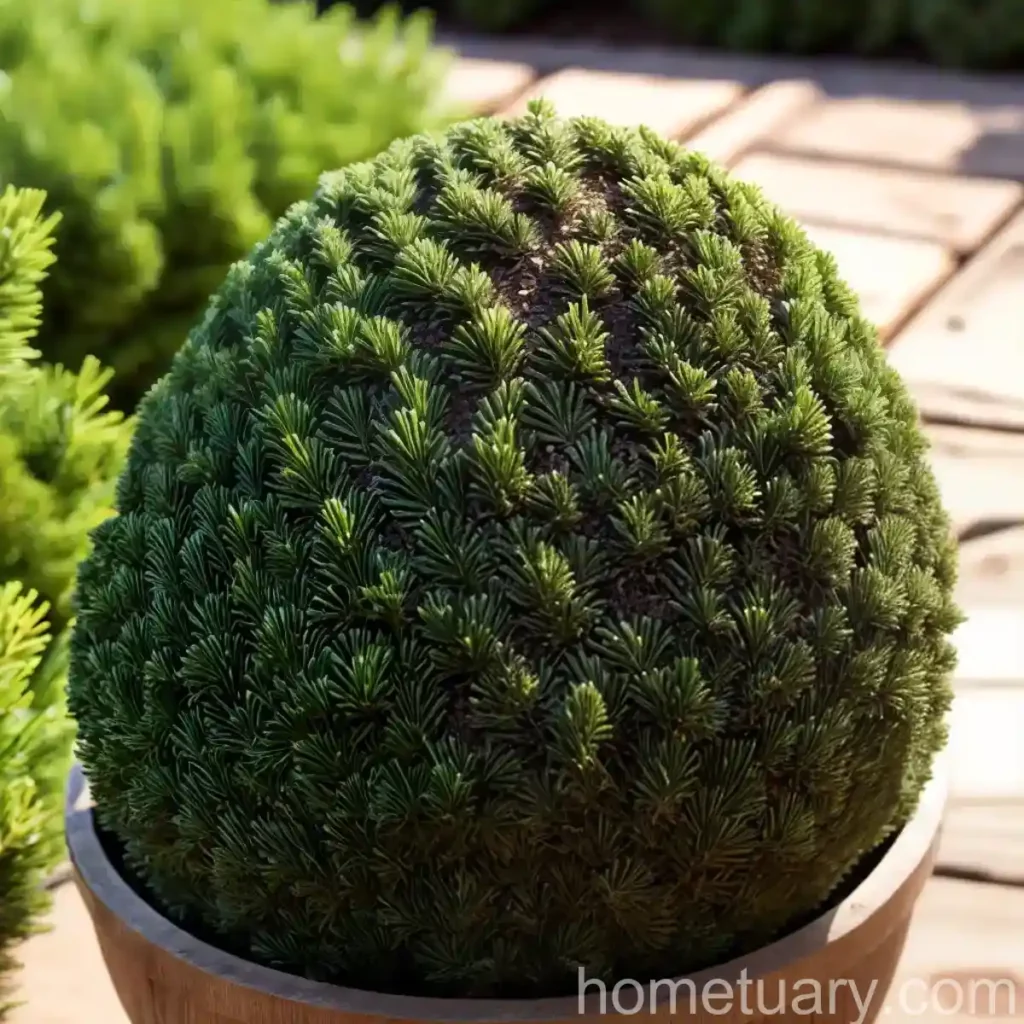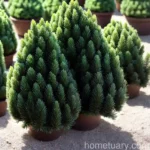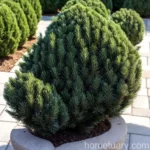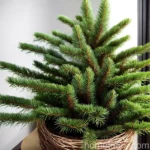Colorado Spruce (Picea pungens ‘Globe’): A Guide to Planting and Growing
Introduction
Colorado spruce, scientifically known as Picea pungens ‘Globe,’ is a stunning evergreen tree prized for its compact, dense, and symmetrical growth habit. In this comprehensive guide, we will explore the various aspects of cultivating and nurturing this magnificent plant, including its cultural requirements, uses in landscaping, propagation techniques, common diseases and pests, and much more. Whether you are a seasoned gardener or a beginner looking to enhance your outdoor space, this article aims to provide you with the knowledge and insights necessary to successfully grow and enjoy the beauty of the Colorado spruce.
What is Colorado Spruce (Picea pungens ‘Globe’)?
The Colorado spruce (Picea pungens ‘Globe’) is a cultivar of the Colorado blue spruce, which is native to the Rocky Mountains of the United States. This compact conifer features a rounded, globe-like shape, making it an excellent choice for ornamental and landscape plantings. The vibrant blue-green needles and sturdy, slow-growing nature further contribute to its popularity among gardeners and landscapers.
Key Takeaways – Colorado Spruce (Picea pungens ‘Globe’)
Before delving into the specific aspects of cultivating the Colorado spruce, let’s highlight some key takeaways about this remarkable plant:
- Scientific Name: Picea pungens ‘Globe’
- Common Name: Colorado spruce
- Growth Habit: Compact, globe-like form
- Foliage: Blue-green, needle-like leaves
- Uses: Ornamental plantings, landscaping, container gardening
- Cultural Requirements: Full sun, well-draining soil, moderate water, and minimal pruning
- Distinctive Features: Drought tolerant, deer resistant, and cold hardy
- Growth Rate: Slow, reaching a mature size of 2-3 feet in height and width
- USDA Hardiness Zones: 2-7
Now, let’s explore each of these aspects in detail to gain a comprehensive understanding of how to care for and grow the Colorado spruce.
Culture
Cultivating Colorado spruce (Picea pungens ‘Globe’) involves understanding and meeting its specific cultural requirements, including watering, sunlight, fertilizer needs, soil conditions, pruning, and propagation techniques.
Water
Proper watering is crucial for the health and vitality of Colorado spruce trees, especially during their establishment phase. Once established, these trees demonstrate good drought tolerance, but they benefit from occasional deep watering during prolonged dry spells. In general, a regular watering schedule is recommended, particularly during hot and dry periods.
Here are some key considerations for watering Colorado spruce:
- Young Trees: Newly planted Colorado spruce trees should be watered deeply immediately after planting and regularly during the first growing season to encourage healthy root development.
- Mature Trees: Once established, mature Colorado spruce trees typically require infrequent watering, relying on natural precipitation in most cases. However, during extended periods of drought, supplemental irrigation may be necessary to maintain optimal growth and appearance.
Sunlight
Colorado spruce thrives in full sun to partial shade, preferably in a location that receives at least 6-8 hours of direct sunlight each day. Adequate sunlight exposure is essential for promoting dense and compact growth, enhancing the characteristic blue-green color of the foliage, and ensuring overall vigor and resilience.
When selecting a planting site for Colorado spruce, consider the following sunlight requirements:
- Full Sun: Ideal for maximizing the tree’s growth potential and maintaining its vibrant foliage color.
- Partial Shade: Tolerated, especially in regions with hot summers, but may result in slightly looser growth and a lighter green hue in the needles.
Fertilizer
Proper fertilization is essential for supporting the growth and vitality of Colorado spruce (Picea pungens ‘Globe’). While these trees are not heavy feeders, applying a well-balanced, slow-release fertilizer can help optimize their health and appearance.
Consider the following guidelines for fertilizing Colorado spruce:
- Timing: Fertilize in early spring before the onset of new growth to provide essential nutrients for the upcoming growing season.
- Type of Fertilizer: Use a balanced, slow-release fertilizer specifically formulated for evergreen trees. Avoid applying excessive amounts of nitrogen, which can result in overly vigorous growth and reduced cold hardiness.
Soil
Colorado spruce thrives in well-draining, slightly acidic soils with a pH range of 6.0-7.5. Good soil drainage is crucial for preventing waterlogged conditions, which can lead to root rot and other issues. When planting or transplanting Colorado spruce, it is advisable to amend the soil with organic matter, such as compost or peat moss, to improve its texture and moisture retention capabilities.
Here are some key considerations for soil preparation:
- Drainage: Ensure that the planting site has adequate drainage to prevent water from pooling around the tree’s roots.
- Soil Amendments: Incorporate organic matter into the soil when planting or transplanting to enhance its fertility and structure.
Pruning
Colorado spruce (Picea pungens ‘Globe’) generally requires minimal pruning, thanks to its naturally compact and symmetrical growth habit. However, occasional pruning may be necessary to maintain its desired shape and remove any dead, damaged, or overgrown branches.
Follow these pruning tips to ensure the health and aesthetics of Colorado spruce:
- Timing: Conduct pruning during the tree’s dormant season, typically in late winter to early spring, to minimize stress and maximize recovery.
- Techniques: Use clean, sharp pruning tools to make precise cuts and avoid causing unnecessary damage. Focus on selective and minimal pruning to preserve the tree’s natural form and structure.
Propagation
While Colorado spruce (Picea pungens ‘Globe’) is primarily propagated through grafting and cutting methods to preserve its characteristic traits, it is possible to grow new trees from seed. However, bear in mind that seed-grown Colorado spruce may exhibit variable traits and take longer to reach maturity compared to grafted specimens.
Here is a basic outline of the seed propagation process for Colorado spruce:
- Seed Collection: Collect mature cones from the tree during the autumn season when they begin to naturally open and release their seeds.
- Seed Preparation: Extract the seeds from the cones and store them in a cool, dry location until the following spring.
- Sowing Seeds: Sow the seeds in well-draining, sterile seed-starting mix in early spring and maintain consistent moisture and warmth to facilitate germination.
- Seedling Care: Transplant the seedlings into individual containers once they develop a few sets of true leaves. Provide adequate sunlight and regular watering as they continue to grow.
Uses
The Colorado spruce (Picea pungens ‘Globe’) offers a range of versatile uses in landscaping, garden design, and horticulture. Its compact size, distinctive foliage color, and cold-hardy nature make it a valuable addition to various outdoor settings.
Landscape Plantings
Colorado spruce is often utilized in landscape plantings for its ornamental appeal and low-maintenance characteristics. Whether used as a focal point in a garden bed, as part of a mixed border, or as a specimen tree on a lawn, its striking appearance and year-round interest make it a popular choice among gardeners and landscape designers.
Here are some common uses of Colorado spruce in landscape plantings:
- Foundation Plantings: Planted near buildings to add structure and visual interest to the foundation area.
- Mixed Borders: Paired with flowering shrubs, perennials, and other evergreens to create a diverse and visually appealing border.
- Rock Gardens: Integrated into rock gardens to bring color and texture to the landscape.
Container Gardening
The compact size and slow growth rate of Colorado spruce make it well-suited for container gardening, allowing individuals with limited outdoor space to enjoy its beauty on patios, balconies, and decks. When grown in containers, it is essential to provide adequate moisture and protection from extreme temperatures to ensure the tree’s well-being.
Consider the following tips for growing Colorado spruce in containers:
- Container Selection: Choose a large, sturdy container with drainage holes to accommodate the tree’s root system and ensure proper drainage.
- Soil and Watering: Use a high-quality potting mix formulated for container plants and maintain regular watering to prevent the soil from drying out completely.
Privacy Screening
The dense, compact growth habit of Colorado spruce makes it an excellent candidate for creating privacy screens and windbreaks in residential and commercial landscapes. When planted in rows or clusters, these trees provide effective visual screening and noise reduction while enhancing the overall aesthetics of the outdoor space.
Utilize Colorado spruce for privacy screening in the following ways:
- Property Boundaries: Use as a living fence to delineate property lines and create a sense of seclusion.
- Outdoor Living Areas: Plant as a backdrop for patios, pools, and outdoor entertainment spaces to enhance privacy and comfort.
Common Diseases
While Colorado spruce (Picea pungens ‘Globe’) is generally resilient and resistant to many pests and diseases, it is susceptible to certain issues under unfavorable growing conditions or in the presence of stress factors. Understanding and identifying common diseases can help in implementing timely management and preventative measures to protect the tree’s health.
Disease Diagnosis
Below are some of the common diseases that may affect Colorado spruce and their typical symptoms:
- Rhizosphaera Needle Cast: Characterized by the browning and premature shedding of needles, particularly in the lower canopy. This fungal disease thrives in humid conditions and can lead to defoliation and weakened tree vitality if left untreated.
- Cytospora Canker: Presents as sunken, discolored areas on the branches and stems, often accompanied by resinous sap exudation. Cytospora canker can cause branch dieback and overall decline in tree health.
- Needle Rusts: Manifests as yellow-orange pustules or spots on the needles, indicating the presence of rust fungi. While not typically lethal, heavy infections can result in defoliation and aesthetic decline.
It is essential to monitor the tree regularly for any signs of disease and consult with a professional arborist or plant health specialist for accurate diagnosis and treatment recommendations.
Common Pests
Colorado spruce (Picea pungens ‘Globe’) is generally resistant to major pest infestations, but it can be affected by certain insect pests under specific conditions. Being vigilant and proactive in pest management can help prevent significant damage to the trees and preserve their overall health and appearance.
Some of the common pests that may target Colorado spruce include:
- Spruce Spider Mites: Tiny arachnids that feed on the needles, causing stippling and discoloration. High populations can lead to noticeable webbing and reduced tree vigor.
- Adelgids: Soft-bodied insects that feed on the sap of the tree, often leading to stunted growth, distorted foliage, and premature needle drop.
- Spruce Needleminer: Larvae of this moth species tunnel into the needles, causing browning and distortion. Severe infestations can result in significant defoliation.
Implementing integrated pest management strategies, such as regular inspection, promoting natural predators, and using targeted treatments when necessary, can help mitigate pest pressures effectively.
Botanist’s Tips
To ensure the successful cultivation and long-term health of Colorado spruce (Picea pungens ‘Globe’), consider the following botanist’s tips:
- Selecting Healthy Specimens: When acquiring new Colorado spruce trees, choose healthy, well-branched specimens with vibrant foliage and no visible signs of stress or damage.
- Site Selection: Plant Colorado spruce in a location that meets its sunlight and soil requirements, providing ample space for it to reach its mature size without overcrowding.
- Mulching: Apply a layer of organic mulch around the base of the tree to regulate soil temperature, conserve moisture, and discourage weed growth.
- Regular Monitoring: Regularly inspect the tree for signs of diseases, pests, and environmental stress, and take prompt action if issues are identified.
Fun Facts
Let’s explore some intriguing and fascinating facts about Colorado spruce (Picea pungens ‘Globe’):
- The striking blue-green color of the Colorado spruce’s needles is attributed to a waxy coating that helps protect the tree from moisture loss and environmental stress.
- Colorado spruce has been widely used in urban landscapes and city parks due to its adaptability to various soil and climatic conditions.
- Historically, native American tribes utilized parts of the Colorado spruce for medicinal and ceremonial purposes, recognizing the tree’s valuable contributions to their livelihoods.
- Colorado spruce is a favorite choice for holiday greenery and Christmas tree production, valued for its symmetrical form and excellent needle retention.
Now that we have explored various aspects of Colorado spruce (Picea pungens ‘Globe’), including its cultural requirements, uses in landscaping, propagation techniques, common diseases, and pests, it’s time to expand our knowledge through external resources and further reading.
Links to External Resources
For additional information on growing and caring for Colorado spruce, as well as insights into its landscaping uses and maintenance, consider exploring the following external resources:
- The Spruce – Colorado Spruce Tree Profile
- University of Florida IFAS Extension – Growing Colorado Blue Spruce in the Landscape
- Missouri Botanical Garden – Picea pungens ‘Globosa’
- Royal Horticultural Society – Colorado Blue Spruce
Conclusion
In conclusion, Colorado spruce (Picea pungens ‘Globe’) is a captivating and versatile evergreen tree that brings beauty, resilience, and functionality to various outdoor settings. By understanding and meeting its cultural requirements, leveraging its uses in landscaping, and being vigilant in disease and pest management, gardeners and enthusiasts can cultivate thriving and stunning Colorado spruce specimens. Whether incorporated into ornamental gardens, used for privacy screening, or featured in containers, the appeal and impact of this remarkable tree are undeniable, making it a cherished element in horticulture and urban green spaces. We hope that this guide has equipped you with the knowledge and inspiration to embark on your own journey of planting and growing Colorado spruce, adding a touch of natural elegance to your outdoor environment.
Remember to consult with local horticultural experts, nursery professionals, or extension services for tailored advice and recommendations based on your specific geographic location and growing conditions. Happy planting, and may the Colorado spruce enrich your landscape for years to come!















